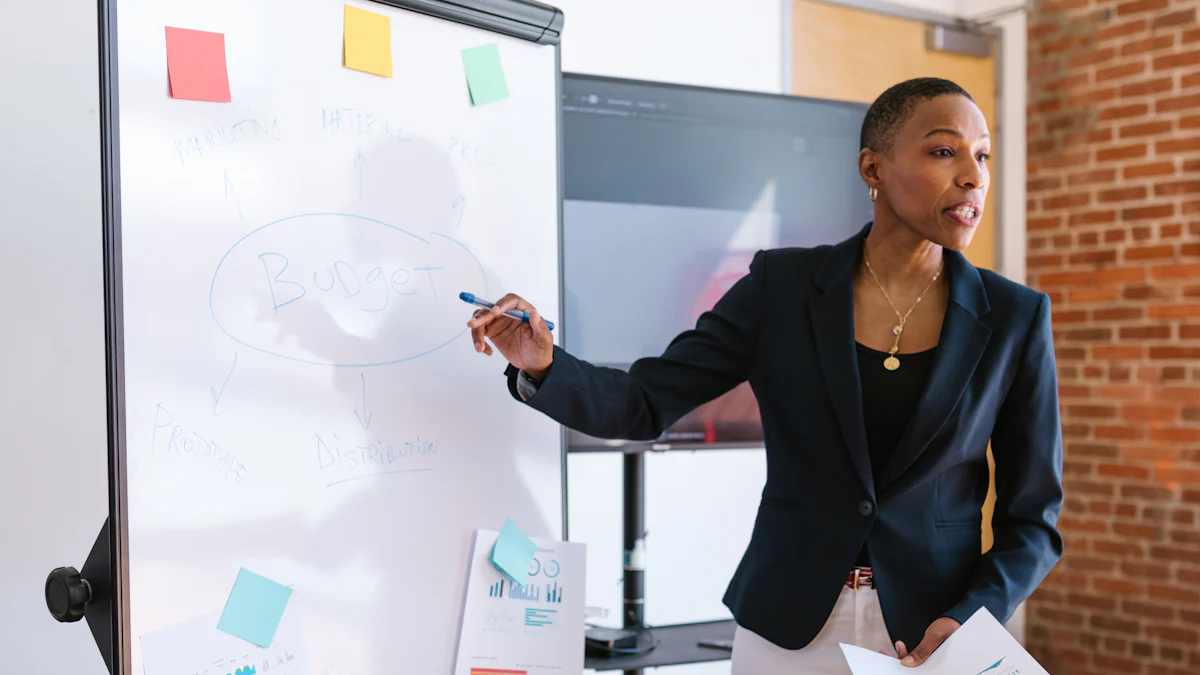10 Proven Strategies for Engaging Your Audience in Presentations

Have you ever felt like your audience just wasn’t connecting with your presentation? You’re not alone. Many presenters struggle with audience engagement in presentation. But here’s the thing—when you truly connect with your listeners, everything changes. Engaged audiences feel more comfortable, participate actively, and trust your message. For example, Microsoft’s transformation under Satya Nadella shows how prioritizing open communication and feedback can create meaningful connections. By understanding your audience’s needs and keeping your message relatable, you can turn a simple presentation into a memorable experience that enhances audience engagement in presentation.
Start Strong to Capture Attention

The first few moments of your presentation are critical. This is when your audience decides whether to tune in or zone out. Starting strong can grab their attention and set the tone for the rest of your talk. Let’s explore three ways to make an unforgettable opening.
Open with a Powerful Quote or Statistic
A well-chosen quote or statistic can immediately hook your audience. It makes them curious and eager to hear more. For example:
- Did you know that 85% of people feel nervous about public speaking?
- Every minute, 500 hours of video are uploaded to YouTube.
- By 2030, experts predict that artificial intelligence will replace 30% of jobs.
These kinds of statements work because they’re surprising or relatable. They also appeal to the brain’s natural curiosity. When you start with something unexpected, your audience pays attention. This technique leverages the serial position effect, which means people remember the first thing they hear. So, make it count!
Share a Personal Story or Anecdote
Stories are powerful. They create an emotional connection and make your message more relatable. Think about a time when you faced a challenge or learned a valuable lesson. Share it with your audience. For instance, if you’re presenting on teamwork, you could talk about a group project that went wrong and what you learned from it. Personal stories humanize you as a speaker. They also make your audience feel like they’re part of a conversation, not just listening to a lecture.
Ask a Provocative or Thought-Provoking Question
Questions are a great way to engage your audience right away. They make people think and invite them to participate mentally. Try asking something like, “What would you do if you only had 24 hours to solve a major problem?” or “Have you ever wondered why some presentations stick with you while others don’t?” Questions like these spark curiosity and encourage your audience to reflect. They also cater to different learning styles, making your presentation more inclusive.
Starting strong is all about creating a connection. Whether you use a quote, a story, or a question, the goal is the same: to capture attention and set the stage for meaningful audience engagement in presentation.
Foster Interaction and Participation
Engaging your audience isn’t just about talking at them—it’s about involving them in the conversation. When you foster interaction, you create a dynamic environment where everyone feels included. Let’s dive into three ways to make your presentation more interactive.
Use Live Polls, Quizzes, or Surveys
Interactive tools like live polls or quizzes can transform your presentation into a two-way experience. They’re perfect for gauging opinions, testing knowledge, or simply breaking the ice. Imagine asking your audience, “What’s the biggest challenge you face in public speaking?” and seeing their responses in real time. It’s a great way to spark discussion and keep everyone engaged.
Here’s a quick comparison of popular tools you can use:
| Tool | Advantages | Disadvantages |
|---|---|---|
| Mentimeter | Language accessibility for global audiences. | No automatically generated reports. |
| Vevox | Most comprehensive free version available. | Works best with Microsoft products. |
| Sli.do | Comprehensive analytics tools for larger organizations. | Limited interesting or connective uses. |
| Poll Everywhere | Best free and start-up packages for live polls. | Free options very limited in features. |
| Aha Slides | Affordable with interactive features like idea sharing. | Only basic analytics and presentation options. |
Choose a tool that fits your needs and watch your audience engagement in presentation soar.
Incorporate Q&A Sessions During or After the Presentation
Q&A sessions are a fantastic way to connect with your audience. They allow you to address their specific concerns and make your presentation feel more personal. Encourage participants to submit questions in advance. This gives you time to prepare thoughtful responses and ensures the discussion stays relevant. During the session, listen actively and tailor your answers to their background. This builds rapport and makes your audience feel heard.
To keep things dynamic, ask well-structured questions yourself. For example, “What’s one thing you’d change about how presentations are delivered today?” This approach invites collaboration and keeps the energy high.
Encourage Quick Feedback with a Show of Hands
Sometimes, the simplest methods are the most effective. Asking for a quick show of hands is an easy way to gauge opinions or check understanding. For instance, you could ask, “How many of you have used live polling tools before?” This not only gets your audience involved but also gives you instant feedback. In virtual settings, you can adapt this by using reaction buttons or chat features.
To make it even more engaging, alternate between in-person and virtual participants if you’re presenting in a hybrid format. This ensures everyone feels included, no matter where they are.
By fostering interaction, you turn your presentation into a collaborative experience. Whether it’s through polls, Q&A sessions, or simple gestures like a show of hands, these strategies make your audience feel valued and connected.
Make Content Relatable and Relevant
Your audience will stay engaged when they feel the content speaks directly to them. Making your presentation relatable and relevant ensures your message resonates and leaves a lasting impression. Here’s how you can do it.
Tailor Your Message to the Audience’s Needs and Interests
Every audience is unique, so your presentation should reflect that. Start by understanding who you’re speaking to. Are they executives, product partners, or legal teams? Each group has different goals and pain points. For example:
- Executives might care about high-level strategies and ROI.
- Product partners may want actionable insights or technical details.
- Legal teams often focus on compliance and risk management.
When you tailor your message to their needs, you show that you’ve done your homework. This builds trust and keeps them engaged. Ask yourself, “What does my audience want to achieve?” Then, align your content with their priorities.
Tip: Use pre-event surveys or quick polls to learn more about your audience before you present.
Use Real-Life Examples or Case Studies
Stories of real-world success make your content relatable and credible. Case studies, in particular, are powerful tools. Did you know that 73% of successful marketers use case studies to connect with their audience? They work because they show how others have solved similar problems.
Here are a few examples:
- Jasper AI partnered with Omniscient Digital and saw an 810% increase in blog sessions.
- Meliá Hotels improved customer service response times with Hootsuite.
- WeightWatchers used HubSpot to transform their sales strategy, achieving seven-figure annual contracts.
These examples demonstrate the impact of relatable content. They also inspire your audience to imagine similar success for themselves.
Address Common Challenges or Pain Points
Your audience likely shares common struggles. Addressing these challenges shows you understand their world. Some frequent issues include:
- Staying focused during long presentations.
- Simplifying complex ideas into clear messages.
- Managing time effectively to avoid rushing or running over.
By acknowledging these pain points, you create an instant connection. Offer practical solutions, like breaking up long sessions with interactive elements or using visuals to clarify complex topics. When you solve their problems, you boost audience engagement in presentation and make your talk memorable.
Note: If technical difficulties arise, stay calm and have a backup plan. Your composure will reassure your audience.
Relatable and relevant content transforms a presentation from ordinary to extraordinary. When you tailor your message, share real-life examples, and address challenges, you create a meaningful experience for your audience.
Leverage Storytelling for Emotional Connection

Stories have a unique way of drawing people in. They tap into emotions, making your message more memorable and impactful. By weaving storytelling into your presentation, you can create a deeper connection with your audience.
Structure Your Presentation Like a Narrative
Think of your presentation as a story with a beginning, middle, and end. Start by setting the stage. Introduce the problem or challenge your audience can relate to. Then, guide them through the journey of overcoming it. Finally, end with a resolution that leaves them inspired or motivated.
For example, Airbnb uses this approach effectively. They show how their platform helps people earn or save money, creating a win-win scenario. This narrative not only engages the audience but also highlights the mutual benefits of their service. Similarly, Simon Sinek’s famous TED Talk uses storytelling to connect emotionally, making his message unforgettable.
When you structure your presentation like a story, you give your audience a reason to stay invested. They’ll want to know how it ends.
Highlight Key Characters, Events, or Turning Points
Every great story has characters your audience can root for. These characters don’t have to be people—they can be ideas, products, or even your audience themselves. Make them relatable by giving them flaws, fears, or aspirations. For instance, if you’re presenting a new product, position your audience as the hero and your product as the tool that helps them succeed.
Turning points are equally important. Highlight moments of change or realization. These keep your audience engaged and make your story more dynamic. Intercom, for example, uses this technique by showing how their solutions simplify complex problems. This approach resonates because it mirrors the audience’s own challenges.
Use Descriptive Language to Create Vivid Imagery
Words have the power to paint pictures. Use descriptive language to make your story come alive. Instead of saying, “The garden was beautiful,” try, “The sun-kissed petals of a blooming marigold garden swayed gently in the breeze.” This kind of imagery helps your audience visualize and feel your story.
Imagine describing a breakthrough moment in your presentation. You could say, “Her eyes sparkled like a thousand stars as she realized the solution was within reach.” These vivid details make your story more engaging and memorable.
Avoid common mistakes like using passive language or predictable plots. Keep your story authentic and visually rich to maintain audience engagement in presentation. When done right, storytelling transforms your presentation into an experience your audience won’t forget.
End with a Memorable Call-to-Action
Ending your presentation with a strong call-to-action (CTA) ensures your audience leaves with clarity and motivation. It’s your chance to inspire action and make your message stick. Let’s explore how you can craft a CTA that resonates.
Summarize Key Takeaways Clearly and Concisely
A clear summary helps your audience remember the most important points. Think of it as a quick recap that ties everything together. To do this effectively:
- Define the main objective of your presentation.
- Highlight the key insights, implications, or recommendations.
- Use bullet points to make your summary easy to follow.
For example, if your presentation focused on improving teamwork, your summary might include:
- The importance of open communication.
- Strategies for resolving conflicts.
- Tools to enhance collaboration.
Ask yourself, “What will my audience care about most?” Then, focus on those points. A well-crafted summary reinforces your message and boosts audience engagement in presentation.
Challenge the Audience to Apply What They’ve Learned
Encourage your audience to take what they’ve learned and put it into action. This makes your presentation more impactful and memorable. You could:
- Pose a question like, “What’s one thing you’ll do differently after today?”
- Suggest a group activity to practice the concepts you’ve shared.
- Use interactive tools like Kahoot! to test their understanding.
Pausing to let them reflect or discuss can also help. When you challenge your audience, you turn passive listeners into active participants. This approach deepens their connection to your message.
Provide Actionable Next Steps or Resources
Don’t leave your audience wondering what to do next. Give them clear, actionable steps. For instance:
- Share structured slides summarizing next steps, like those used by McKinsey or Bain.
- Provide a categorized list of recommendations for easy understanding.
- Offer resources such as articles, templates, or tools to help them get started.
Here’s an example of a simple next steps slide:
- Step 1: Identify your team’s biggest challenge.
- Step 2: Apply one strategy from today’s session.
- Step 3: Share your results in the next meeting.
Direct language removes ambiguity and guides your audience effectively. Pair this with attention-grabbing visuals to make your CTA stand out.
Tip: Test different CTAs to see what resonates best with your audience. Align your message with their goals to maximize impact.
A memorable call-to-action leaves your audience inspired and ready to act. By summarizing key takeaways, challenging them to apply what they’ve learned, and providing actionable steps, you ensure your presentation ends on a high note.
Engaging your audience is the secret to delivering presentations that leave a lasting impression. By applying these 10 strategies, you can create meaningful connections and inspire action. Think about the benefits: building trust, fostering ongoing interaction, and creating memorable moments. Presentations that use storytelling, interactive tools, or relatable examples often stand out. They evoke emotions and keep your audience invested. When you focus on audience engagement in presentation, you don’t just share information—you build relationships that last. Try these strategies in your next talk and see the difference for yourself!
FAQ
How do I keep my audience engaged throughout the presentation?
Focus on interaction. Use tools like live polls or quizzes to involve your audience. Share relatable stories or examples to keep them interested. Break up long sections with visuals or questions. Always tailor your content to their needs.
Tip: Keep your energy high—your enthusiasm is contagious! 🎤✨
What if my audience seems distracted or uninterested?
Don’t panic! Shift gears by asking a question or sharing a surprising fact. Use humor or a quick activity to re-engage them. Adjust your tone or pace to match their energy. Sometimes, a simple pause can refocus attention.
Note: Watch for body language cues to adapt your approach.
How can I make my presentation more interactive?
Incorporate tools like Mentimeter or Poll Everywhere for live feedback. Ask open-ended questions or encourage group discussions. Use props, visuals, or storytelling to spark curiosity. Interaction makes your audience feel involved and valued.
Pro Tip: Start with a fun icebreaker to set the tone! 🧊
What’s the best way to handle audience questions?
Listen carefully and respond with empathy. If you don’t know the answer, admit it and promise to follow up. Keep answers concise and relevant. Encourage others to share their thoughts if time allows.
Reminder: Repeat the question for clarity, especially in large rooms.
How do I end my presentation on a high note?
Summarize your key points clearly. Challenge your audience to take action. Provide resources or next steps to guide them. End with a memorable quote, story, or call-to-action that leaves them inspired.
Call-to-Action: “What’s one thing you’ll do differently after today?” 🚀
See Also
10 Effective Strategies for Engaging Your Audience in 2025
10 Ways to Enhance Audience Interaction Using Zoom
20 Engaging Activities to Captivate Your Audience in 2025
